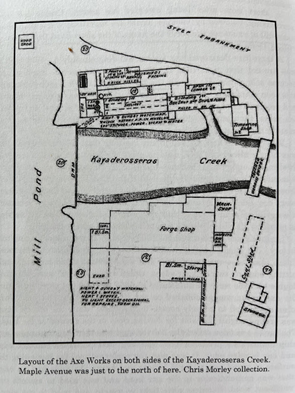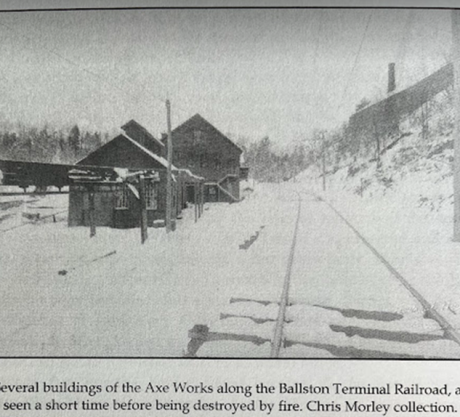The foundation of one of the axe factory buildings is down the hill to your left. Isaiah Blood and his partners began operations in 1851 but the factory burned in 1854. Isaiah rebuilt it bigger and better. The forge shop was located across the creek. It was 40 feet by 120 feet. There were 13 steam powered trip hammers and a variety of other machines (Starr, 2009, p. 65). There were multiple buildings on both sides of the creek. A bridge and a dam were built across the creek.
As you explore the area, you will find grindstones scattered around. Please leave them where they are so they can be enjoyed by future generations. The largest grindstones were 6 feet across and were shipped here from Amherst, Ohio. Even with water dripping on them to cool the stone and metal axe-head, the grindstones would only last about one month (Starr, 2009, p. 67). The factory employees worked on ways to improve the process of blade and axe-head making. Patents were obtained on some of these processes and machines. There were 150 workers between the two factories, and they were so productive that in a year they could use 400 tons of iron, 110 tons of steel, 1300 tons of coal, and 350 tons of grindstones (Starr, 2010, p. 53).
Isaiah Blood died in 1870 and his son-in-law Henry Knickerbocker continued to run the factories until 1890 (Starr, 2009, pp. 68-69). The factories were purchased by the American Axe and Tool Company in 1890. They increased production and by 1892 there were 300 employees. The total weekly payroll was $3000. Between the two factories they produced 1200 scythes, 1700 axes, 1700 hatchets, and 1700 other tools per day (Starr, 2009, p. 70). The axe factory was never rebuilt after a fire in 1901.
Page researched and created by Parker Duthaler for his Eagle Scout Project


